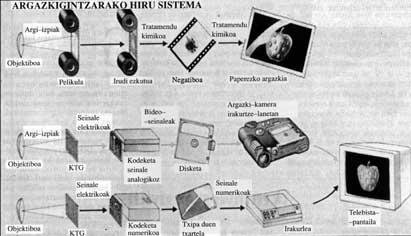Pictures without silver
2002/08/09 Carton Virto, Eider - Elhuyar Zientzia
Although many things have changed since photography was invented, silver has maintained the role of protagonist. Apart from digital cameras, light and silver salts have been the basis of photography for 200 years. When you take pictures, you are turning silver salts into metallic silver. Subsequently, in the laboratory, the film is treated with chemical compounds to obtain the negative. And the same to have the photo in hand.
Colour films, in addition to silver salts, contain red, green and blue light-sensitive colorants in layers. When the photo is taken, silver salt becomes metallic silver as usual, but the lights/shadows are collected in layers. In one of them will be collected the reflection of red, in the other the green and in the last the blue. In the laboratory these reflections are converted into colors by chemical reactions and all the silver is extracted from the film. The process has many steps, is complex and many chemical compounds are used.

Acid instead of silver
The method presented by Polaroid substitutes silver for acid. The process is much simpler than usual and starts and ends automatically when the film is lit. Iodine salts and two acids are the protagonists of the process. Light breaks down iodine salts to give a first acid that causes the synthesis of a second acid. Acids convert dyes into colors and only the process stops when, thanks to a base created on the road, the balance between the acid and the base is reached.
Although the process is complex, everything happens in one step and requires less chemical compounds. In addition, unlike silver salts, it prevents excessive exposure problems to development.
At the moment, the new method is not very sensitive to visible light, so it does not replace conventional cameras, but researchers believe it is very appropriate to work with laser or diodes. It allows to create very clean images in high definition.

Gai honi buruzko eduki gehiago
Elhuyarrek garatutako teknologia





